How to Clean and | Maintain Range Hoods?
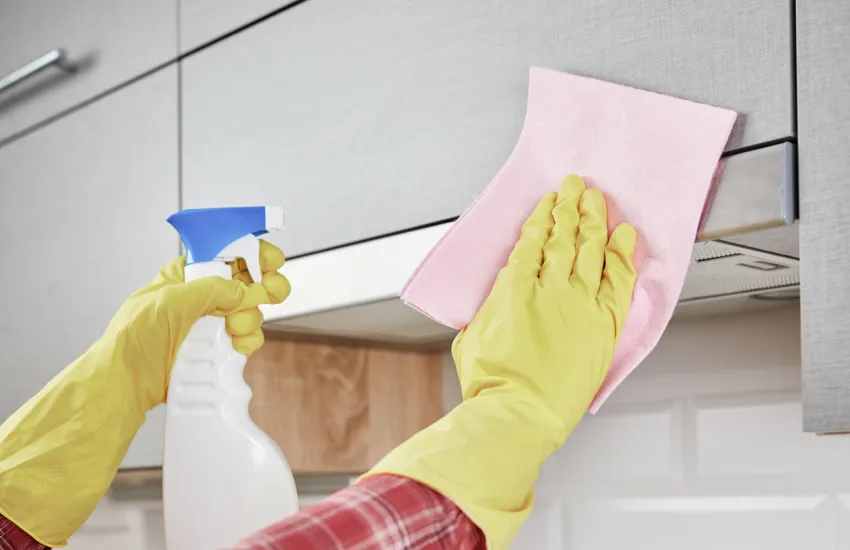
Range hoods are essential for maintaining air quality and cleanliness in the kitchen. Cleaning filters monthly, wiping exteriors after use, and performing a deep clean every 3–6 months ensure safety, efficiency, and a longer appliance life. Follow our comprehensive guide for step-by-step cleaning and pro tips to keep your kitchen fresh.
How to Clean and Maintain Range Hoods?
Your kitchen range hood is the unsung hero in your culinary space, tirelessly working to remove grease, smoke, and odors. Over time, grease and debris can clog its filters, reducing efficiency and creating potential hazards. Regular maintenance not only ensures peak performance but also improves air quality and extends the lifespan of your range hood. Let’s explore the best cleaning practices to keep this vital appliance in top shape!
Your fridge is a kitchen superstar as it keeps all your food fresh and drinks cold.
But does the fridge feel warm when you open it?
Is there water all over the floor?
Fridge issues are the worst!
Why Clean Your Range Hood?
Cleaning your range hood isn’t just about aesthetics or cleanliness; it’s a matter of safety, hygiene, and efficiency. Here’s why it’s essential:
- Improved Efficiency: A clean hood operates more effectively, ensuring smoke and grease are removed swiftly, keeping your kitchen comfortable and odor-free.
- Fire Prevention: Grease buildup in the hood or ducts is a significant fire hazard. Regular cleaning minimizes this risk and keeps your kitchen safer.
- Hygiene Maintenance: Left unchecked, grease and moisture in the hood can harbor bacteria and mold, compromising your kitchen’s cleanliness.
- Extended Lifespan: Dirt and grime cause wear and tear over time. Regular maintenance reduces strain on the motor and other components, saving you money on repairs or replacements.
How Often Should You Clean?
The frequency of range hood cleaning depends on how often you cook and the type of meals you prepare. Here are the general guidelines:
- Filters: For standard use, clean monthly. If you cook often or use a lot of oil and spices, clean them every two weeks.
- Exteriors: Wipe down after every use, especially when preparing greasy meals like fried foods or roasted dishes.
- Deep Cleaning: Perform a thorough cleaning every 3–6 months, or more frequently for heavy use. This includes cleaning filters, interiors, and fan blades.
- Charcoal Filters: Replace them every 3–4 months, as they can’t be cleaned and lose effectiveness over time.
Step-by-Step Cleaning Guide
1. Preparation
Before you begin cleaning, gather all the necessary tools and materials. This ensures a smoother process:
- Tools Needed:
- Degreasing dish soap
- Baking soda and white vinegar
- Non-abrasive sponge or brush
- Microfiber cloths
- Protective gloves
- Screwdriver (if parts need removing)
- Safety Tips:
- Turn off the range hood and unplug it to avoid accidents.
- Lay down newspaper or an old towel to catch drips and debris.
- Tools Needed:
2. Cleaning the Exterior
The exterior is often the first part to show dirt, grease, and fingerprints. Here’s how to tackle it:
- Dust First: Use a soft microfiber cloth or brush to remove loose debris and dust.
- Degrease: Mix warm water with dish soap or use a stainless-steel cleaner. Dip a cloth in the solution and wipe the surface.
- Tough Stains: Make a paste using baking soda and water. Apply to stubborn grease spots and gently scrub with a non-abrasive sponge.
- Rinse and Dry: Wipe with a clean, damp cloth to remove any residue. Dry thoroughly with a microfiber cloth to avoid water spots.
3. Cleaning the Filters
Filters trap grease and debris, so they need regular attention:
- Metal Filters:
- Remove them according to the manufacturer’s instructions.
- Soak in hot, soapy water with a degreasing solution for 15–20 minutes.
- Use a soft brush to scrub away grease.
- Rinse thoroughly and allow to air dry before reinstalling.
- Charcoal Filters:
- These are non-washable. Replace every 3–4 months or as specified by the manufacturer.
- Metal Filters:
4. Cleaning the Interior
Grease and smoke accumulate inside the hood, affecting airflow and performance.
- Spray a degreaser inside the hood, focusing on greasy areas.
- Let it sit for 10–15 minutes to break down grease.
- Wipe down with a damp microfiber cloth or sponge.
- Use baking soda paste for tough stains, scrubbing gently.
- Rinse thoroughly with clean water and dry with a soft cloth.
5. Cleaning the Fan Blades
Fan blades often accumulate stubborn grease:
- Remove the fan cover (if detachable) using a screwdriver.
- Soak the blades in warm, soapy water or a degreasing solution.
- Use a non-abrasive sponge to clean thoroughly.
- Dry completely before reassembling to prevent moisture damage.
Maintenance Tips for Long-Term Efficiency
- Inspect Regularly: Check ducts and vents for blockages or debris every few months.
- Listen to the Motor: Any unusual noises may signal issues with the motor or fan. Address them promptly to prevent breakdowns.
- Ensure Proper Ventilation: Non-recirculating hoods should vent outside effectively. Inspect vents for leaks or obstructions.
- Replace Worn Parts: Timely replacement of filters, seals, or damaged parts keeps the appliance in top condition.
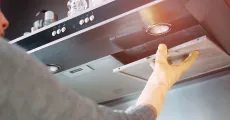
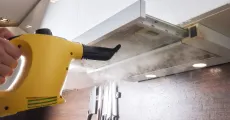
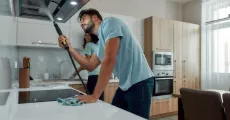
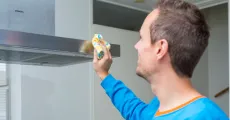

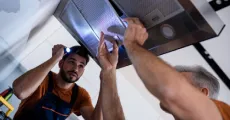
Final Call
Maintaining your range hood isn’t just a chore; it’s an investment in your kitchen’s safety, cleanliness, and efficiency. By following these steps, you can prevent costly repairs and enjoy a healthier cooking environment.
Need professional help? CLT Appliance Repair offers expert kitchen range hood repair and cleaning. Call us today to schedule a service!
FAQs
Clean metal filters monthly or every two weeks for heavy cooking. Replace charcoal filters every 3–4 months or after 120 cooking hours.
Yes, use dish soap, baking soda, and vinegar to degrease and scrub. Always rinse thoroughly and dry to prevent residue or water stains.
Noises may result from loose parts, grease buildup, or blocked ducts. Tighten screws, clean the fan, and check vents for obstructions.
Inspect vents, replace worn parts, and address unusual sounds quickly. Regular maintenance keeps your range hood running efficiently.
Yes, accumulated grease is highly flammable and can ignite from cooking heat. Regular cleaning significantly reduces this fire hazard, keeping your kitchen safe.
Don't let a malfunctioning Range Hood disrupt your daily life. Contact CLT Appliance Repair today at 704-606-9043 to schedule your Range Hood repair service.
We'll have your Range Hood back to optimal performance in no time!.

